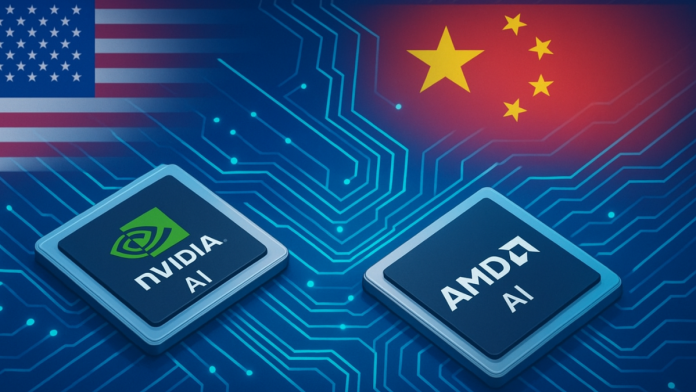Nvidia Corp. and Advanced Micro Devices Inc. (AMD) will hand over 15% of their revenue from certain AI chip sales in China to the US government. The unusual deal, designed to secure export licenses, has drawn attention across the global tech and trade sectors.
A Rare Deal Between US Tech Giants and Washington
The export licenses are essential because, without them, Nvidia and AMD cannot sell their most advanced chips to Chinese buyers. The US had imposed restrictions on such sales, citing national security concerns.
Nvidia’s payment will come from sales of its H20 AI accelerator, a high-performance chip for artificial intelligence applications. AMD will pay the same percentage from its MI308 AI chip sales in China. These processors are used for advanced tasks such as machine learning, large-scale data processing, and cloud computing.
A spokesperson for Nvidia said the company complies with all US export rules and has not shipped H20 chips to China for months. With this new agreement, shipments could resume under strict regulations. AMD has not yet commented publicly on the arrangement.
🇨🇳 Chipgate — DOJ charges Chinese nationals in covert scheme to move Nvidia’s AI tech to Beijing
How Much Money Is Involved?
Nvidia generated $4.6 billion from H20 sales in one fiscal quarter earlier this year. It also reported $2.5 billion worth of orders from China that could not be shipped due to the export rules. This suggests potential quarterly sales to China exceeding $7 billion.
If sales return to that level, the US government could collect about $1 billion every three months from Nvidia’s 15% share.
For AMD, Morgan Stanley projects potential revenue between $3 billion and $5 billion in 2025 from China if restrictions are eased, which would also mean significant payments to Washington under the deal.
While the amounts are small compared to the companies’ total revenue, the arrangement stands out as a rare example of a targeted “export tax” on a specific market and product in modern corporate history.
👁️🗨️Trojan horse at Stanford – Is China using scholarship students as covert intelligence tools?
Why This Matters for Trade and Technology
The deal reflects the approach of former US President Donald Trump, who has often sought substantial financial commitments in exchange for easing trade conditions. Applying this tactic to export controls on advanced technology is unusual.
The US has aimed to limit China’s access to high-end chips, saying they could be used for military purposes. This has hit companies like Nvidia and AMD hard, given China’s status as the world’s largest semiconductor importer.
Chinese state-linked media, including Yuyuantantian — a social media account tied to China Central Television — have criticized the H20 chip as inefficient and suggested it might have security vulnerabilities.
Jacob Feldgoise of the Center for Security and Emerging Technology warned that the US could face difficulty convincing allies to adopt similar restrictions if it appears willing to trade national security measures for financial gain.
🇮🇳 Textiles to tech: How US tariffs on India threaten a $200 billion economic lifeline
Reports indicate that the US Commerce Department began granting H20 licenses soon after Nvidia CEO Jensen Huang met with Trump. Huang has long argued that cutting China off from US chips will slow the spread of American technology and help Chinese rivals such as Huawei Technologies Co. gain market share.
Local Competition and Market Impact
Hebe Chen of Vantage Markets said the move gives Washington a “strategic bargaining chip” in trade negotiations with Beijing. However, she noted that the added costs could discourage Nvidia and AMD from expanding further in China, providing an opening for local semiconductor makers to grow.
According to Morgan Stanley, Chinese-made chips such as Huawei’s Ascend processors now account for 20% to 30% of domestic demand.
Vey-Sern Ling, managing director at Union Bancaire Privée, said the US government’s readiness to collect tariffs and taxes highlights its urgent need for revenue. He also suggested that China’s claims about security backdoors in the H20 may be a negotiation tactic to show it does not rely heavily on US technology.
With this new agreement, Nvidia and AMD may regain access to an important market, but they will also be handing a significant share of their earnings from China directly to Washington. This deal underscores how global technology competition is reshaping business relationships between governments and the private sector.


